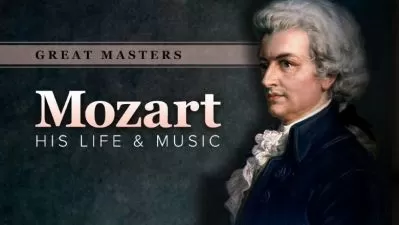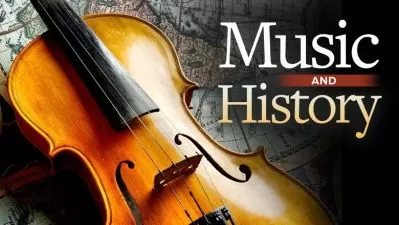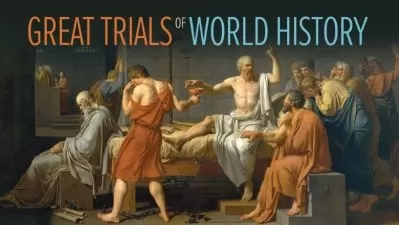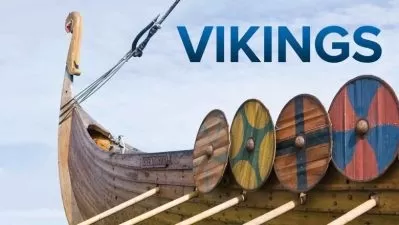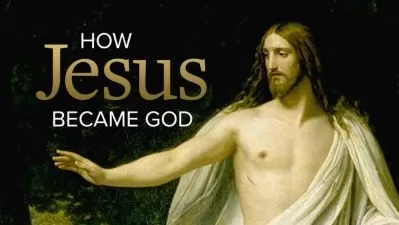A History of European Art
William Kloss
24:11:54
Description
The development of the arts in Europe from the Middle Ages to the modern era is an astonishing record of cultural achievement, from the breathtaking architecture of Gothic cathedrals to the daring visual experiments of the Cubist painters.
We all have our favorite artists, periods, or styles from this immensely rich tradition, but how many of us truly know the full sweep of European art? How many of us can connect the dots of influences and inspiration that link the Renaissance with Mannerism, or that tie the paintings of the creator of modern art, Edouard Manet, to masterpieces from centuries earlier?
A History of European Art is your gateway to this visually stunning story. In 48 beautifully illustrated lectures you will encounter all the landmarks you would expect to find in a comprehensive survey of Western art since the Middle Ages. Works such as Giotto's Arena Chapel, Van Eyck's Ghent Altarpiece, Leonardo's The Last Supper, Michelangelo's David, Vermeer's View of Delft, Van Gogh's The Starry Night, Picasso's Guernica, and hundreds more.
You will also find works that are completely new to you. Plus you'll be introduced to lesser-known artists—perhaps names you've heard but never connected to specific works—and you'll understand why they deserve to be classed among the great masters.
An Unrivalled Collection of Masterpieces
Your guide to this unrivalled collection of paintings, sculptures, architecture, drawings, and other media, created over a span of more than a thousand years, is Professor William Kloss, an independent art historian long connected with the seminar and tour programs of the Smithsonian Associates at the Smithsonian Institution.
Praised by Library Journal for his "perceptive 'readings'" of masterworks in his previous course for The Teaching Company, Great Artists of the Italian Renaissance, Professor Kloss once again gives intriguing insights into great works, including:
- Mona Lisa: The famous smile in Leonardo's painting may be a pun on the sitter's married name, which means "joyous" in Italian. Renaissance ideals of decorum could also have influenced the expression. A 16th-century Italian writer suggested that a fashionable woman should smile "as if you were smiling secretly... not in an artificial manner, but as though unconsciously ... and accompanied by ... certain movements of the eyes."
- Garden of Earthly Delights: Hieronymus Bosch's surreal triptych depicting scenes of the Garden of Eden, an earthly bacchanal, and Hell was probably painted for the private enjoyment of a nobleman, as a moralizing commentary on the relations between the sexes. It has been suggested that the work might have been commissioned on the occasion of a wedding. "One can only hope that it was a happy marriage," says Professor Kloss.
- Sunday Afternoon on the Island of the Grande Jatte: Professor Kloss shows how this celebrated late 19th-century painting by Georges Seurat was influenced by the 15th-century works of Piero della Francesca, who was still relatively unknown in Seurat's day. Both artists imbue nearly immobile figures with stoic dignity and hints of otherworldliness. In fact, it is not just Piero but the entire monumental Italian tradition from Giotto to Masaccio to Piero that Seurat has revisited.
What You Will Learn
You begin by exploring the artistic riches of the Middle Ages, from the early architectural monuments of the Carolingian Empire to the massive cathedrals and exquisite sculpture of the French Gothic style. Then you move into the Renaissance by examining Giotto's approach to the illusionistic creation of space and tracing this accomplishment through the works of some of the greatest artists in history, from Masaccio and Donatello to the geniuses of the High Renaissance, including Leonardo, Michelangelo, Raphael, Bellini, and Titian. You also study the magnificent architecture of the period, and you address the Renaissance in the north through the art of Jan van Eyck, Dürer, Bosch, and Bruegel, among others.
Next, you investigate the evolution of Baroque style in the works of Caravaggio and the Bolognese Carracci family. You focus in particular on the Baroque sculptor and architect Gian Lorenzo Bernini. You continue beyond Italy to Velázquez in Spain, to Rubens and Rembrandt in the Netherlands, and to Versailles and the court of Louis XIV in France. Then you cover reactions to the Baroque in the Rococo style of Watteau, Boucher, and Fragonard.
In the last section of the course, you examine the beginnings of modern European art with the work of David, which defined the Neoclassical style. Then you explore the paintings of the great Romantic artists Goya, Géricault, and Delacroix. These styles gave way to the Realism of Courbet and Manet, which in turn, led to the Impressionist achievements of Degas and Monet. You study the reactions to Impressionism in the work of Gauguin, Van Gogh, and Seurat, and trace the influential contributions of Cézanne and Rodin. You conclude with a consideration of the early movements of the 20th century, including Fauvism, Cubism, German Expressionism, Dada, and Surrealism, and the pivotal role of the two towering geniuses of early modern art, Picasso and Matisse.
A Guide to Looking
Professor Kloss wants you to learn to see deeply into a work of art. To achieve this goal, he has designed the course to be more than a recitation of masterpieces and their makers, dates, materials, and history. He has created a guide to looking—an engaging demonstration of how you can view art with understanding and pleasure.
How should you look at art? Professor Kloss recommends that you focus on five elements:
- Subject: Every work of art has a subject. Very often this is the story that the work tells, as in Titian's great painting Bacchus and Ariadne, which plunges the viewer into a joyous love story drawn from ancient mythology. One can simply revel in the physical beauty of such a work, but a much richer experience is available if one takes the trouble to understand what it is about.
- Interpretation: The way a subject is expressed in art is the artist's interpretation. Professor Kloss explores this theme by looking at three different versions of St. Matthew writing his gospel: one by an unknown artist from the 9th century, and two radically different interpretations by Caravaggio, painted in the 17th century. Caravaggio had to do a second version because his client was offended by the first!
- Style: The artistic means of interpretation is the artist's style. This distinction is evident in a comparison between Rogier van der Weyden's Deposition from the 15th century and Rubens's treatment of the same subject in the 17th century. Both paintings depict the lowering of the dead Christ from the cross, but in markedly different styles with respect to setting, arrangement of figures, treatment of space, color, and so forth.
- Context: The context can be related to a personal moment, to contemporary political events, to a historical period, or to a long-term cultural influence. An appreciation of the great palace at Versailles, for example, requires an understanding of the context from which it emerged—namely, the opulent, absolute monarchy of the "Sun King," Louis XIV.
- Emotion: Emotion is a major factor both in the artist's creation of a work and in the viewer's response to it. These are not necessarily the same emotion, but sometimes they coincide in a magical way, as in Renoir's festive Luncheon of the Boating Party, which evokes a pleasure that comes from Renoir's joy in the scene and his artistic mastery that convinces us that we, too, are included in this long-ago gathering of friends.
Above all, you must give a work of art time. Savor it. Study it. Try to see it with fresh eyes. You will learn more than you imagine. Professor Kloss's gift for pulling you into an artistic work to show you what makes it function at different levels will make you want to give this course more of your own time through repeated viewings. And you will find yourself looking at all art with new appreciation.
More details
User Reviews
Rating
William Kloss
Instructor's CoursesProfessor William Kloss is an independent art historian and scholar who lectures and writes about a wide range of European and American art. He was educated at Oberlin College, where he earned a B.A. in English and an M.A. in Art History. He continued his postgraduate work on a teaching fellowship at the University of Michigan and was then awarded a Fulbright Fellowship for two years of study in Rome. As Assistant Professor of Art History at the University of Virginia, he taught 17th- and 18th-century European art and 19th-century French art. Professor Kloss has enjoyed a long association with the Smithsonian Institution, presenting more than 150 courses in the United States and abroad on subjects ranging from ancient Greek art to Impressionism to the works of Winslow Homer. He has also been a featured lecturer for the National Trust for Historic Preservation and for The Art Institute of Chicago. Professor Kloss serves on the Committee for the Preservation of the White House, a presidential appointment he has held since 1990. He is the author of several books, including Art in the White House: A Nation's Pride (2nd edition), which won the 2009 National Indie Excellence Award in the Art Category, as well as a 2009 USABookNews award for Best Book in Art. Most recently, he coauthored the United States Senate Catalogue of Fine Art. He also has written articles published in Winterthur Portfolio, The Magazine Antiques, American Arts Quarterly, and Antiques & Fine Art.

The Great Courses
View courses The Great Courses- language english
- Training sessions 48
- duration 24:11:54
- English subtitles has
- Release Date 2023/04/27








